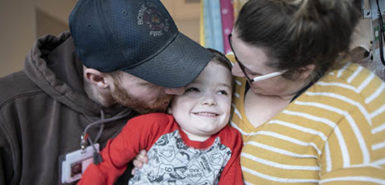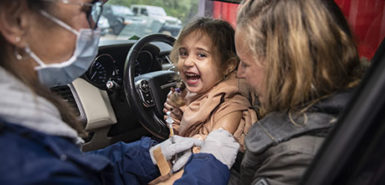
A rare but devastating polio-like virus appears to have made itself at home in the United States, partially paralyzing hundreds of children.
There have been 127 cases reported in 22 states so far this year, with 62 confirmed as acute flaccid myelitis, said Dr. Nancy Messonnier, head of the National Center for Immunization and Respiratory Diseases at the U.S. Centers for Disease Control and Prevention. She announced the numbers in a Tuesday media briefing.
This year’s outbreak marks the third wave of acute flaccid myelitis (AFM) to hit the United States since 2014, and this wave is on track to be the worst yet, experts say.
Even more troubling, the actual number of cases might be even higher. A recent CNN report found that 30 states were investigating 47 confirmed cases and another 49 suspected cases.
AFM cases tend to start in August, peak in October and taper off by December, according to the CDC.
“We need to pay attention to this, because the long-term consequences the children and their parents suffer is immense,” said Dr. Carlos Pardo-Villamizar, a neurological disease expert with Johns Hopkins University School of Medicine in Baltimore. “You can’t imagine the amount of suffering these kids have in their lives.”
Our Take
Bill Bush, MD, pediatrician in chief at Spectrum Health Helen DeVos Children’s Hospital, says this viral illness is seen every year in the United States, although it is not common.
“The CDC talks about this being over one in a million cases,” Dr. Bush said. “So it’s very rare.”
He said Helen DeVos Children’s Hospital has not had any cases of acute flaccid myelitis this year, but the hospital’s team of neurology, radiology, and other pediatric experts are closely monitoring for it, in accordance with CDC guidelines.
If they contract the virus, children may have an arm or leg that seems numb to them or loses function, Dr. Bush shared, and they may experience neurologic symptoms such as drooling or facial changes. He said such symptoms should be immediately evaluated by a physician.
For some, he said, recovery may be quick, and for others it may take some time and rehabilitation to regain neurologic function.
In terms of prevention, he suggests using appropriate mosquito protection as well as following good hygiene practices.
“Best advice: Keep those hands washed,” he said.
Viral culprits?
Acute flaccid myelitis first appeared in 2014, when 120 children across 34 states were stricken with mysterious muscle weakness.
Another wave hit in 2016, with 149 patients affected in 39 states.
The syndrome is suspected to be caused by one or more viruses. Enterovirus (EV) D68, a virus from the same family as polio, is the leading suspect, having been closely linked to the 2014 outbreak, Pardo-Villamizar said.
But according to Dr. Keith Van Haren, “There’s a likelihood it may be associated with other viruses.” He is an assistant professor and child neurologist at the Stanford University School of Medicine. A research team led by Van Haren was the first to link acute flaccid myelitis with EV D68, back in 2015.
But an outbreak of the syndrome now occurring in Colorado has been associated with enterovirus A71, a strain that is much more common in southeast Asia, said Dr. Samuel Dominguez, a pediatric infectious disease expert with Children’s Hospital Colorado.
CDC officials have not confirmed any specific cause of AFM, Messonnier said. Samples from some patients revealed the presence of enteroviruses, but others had been infected with a rhinovirus.
The CDC also hasn’t ruled out either environmental toxins or some sort of autoimmune disorder as potential causes of AFM, Messonnier added.
“I am frustrated that despite all our efforts we haven’t been able to identify the cause of this mystery illness,” Messonnier said.
Devastating symptoms
Acute flaccid myelitis typically causes weakness in the arms and legs, but can affect other muscle groups. In the most severe cases, patients suffer respiratory failure when the muscles involved with breathing become weak, the CDC says.
Follow-up with patients from the 2014 and 2016 waves has shown that most children do not recover from acute flaccid myelitis, for which there currently is no cure.
In September, Pardo-Villamizar and his colleagues published a follow-up of 16 patients stricken in 2016 that concluded that “the majority of children with AFM have limited motor recovery and continued disability.” The study was published in the journal Developmental Medicine and Child Neurology.
Doctors in Colorado experienced the same with children who fell ill in 2014, Dominguez said.
“We followed our children for over a year,” Dominguez said. “Several of the kids did recover, but the majority of them still had permanent deficits a year out.”
The particular strain of virus might have something to do with the severity of AFM and how long its effects last.
“There’s better recovery this year in the kids we’re seeing here with EV A71,” Dominguez said, as opposed to EV D68.
At this point, doctors aren’t sure how the viruses cause acute flaccid myelitis.
Pardo-Villamizar said, “We don’t know if the virus is attacking directly the spinal cord, or if the immune response against the virus is producing the damage to the spinal cord.”
Still rare
The experts emphasized that even though AFM is regularly passing through the United States, it remains a rare illness.
Most kids who contract an enterovirus only suffer an upper-respiratory infection, Pardo-Villamizar and Dominguez said. It’s only a small handful of children who progress to the muscle weakness associated with AFM.
There’s no vaccine that can protect against AFM-causing enteroviruses. Parents who want to protect their children should encourage the same sort of good hygiene that protects kids against cold and flu, such as washing their hands frequently and covering coughs or sneezes, Dominguez said.
“Good advice now is good advice going into the influenza season,” Dominguez said.
Parents of a sick child should be on the lookout for any signs of weakness in the arms or legs, Pardo-Villamizar said.
“If children develop an upper-respiratory infection and there is any hint of muscle weakness, those patients need to be evaluated rapidly by a pediatrician and an emergency department,” he said. “They need to be followed very carefully, because this is a very aggressive disease. In a matter of hours, the children are paralyzed. They may need respiratory support.”

 /a>
/a>
 /a>
/a>
 /a>
/a>